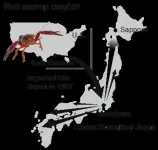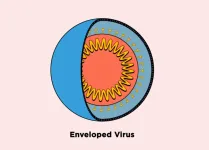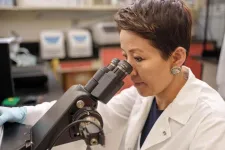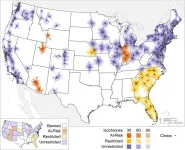“We searched for human genetic variation that associates with spontaneous control of HIV and identified a novel region in the genome that is only variable in populations of African ancestries,” says Professor Jacques Fellay at EPFL’s School of Life Sciences. “We used a combination of computational and experimental approaches to explore the biological mechanism behind the genetic association and provide evidence that the gene CHD1L acts to limit HIV replication in a subset of white blood cells.”
HIV is still a problem
Despite significant advances in treatment and access to therapy, the human immunodeficiency virus remains a global health challenge with almost 40 million affected individuals, no vaccine and no cure. The virus attacks the person’s immune cells (helper T cells, macrophages, and dendritic cells) damaging their ability to mount an immune response. Without treatment, the infected person grows more susceptible to opportunistic infections and cancer, and can develop acquired immunodeficiency syndrome, the well-known AIDS.
Although annual HIV infections have been declining because of widespread antiretroviral therapies, the trend has slowed substantially since 2005, and there are now alarming increases in the number of newly infected adults in some regions.
HIV and studies on the human genome
The way to therapies involves fundamental research, including studies into the relationship between the human genome and the progression of HIV infection, which can reveal possible therapeutic targets.
These Genome-Wide Association Studies, or GWAS, analyze the entire genome of a large number of individuals to identify genetic variants associated with a clinical outcome, such as the ability to naturally control viral replication.
Measuring HIV replication control: not enough in African populations
The degree of viral infection is measured by the virus’ “setpoint viral load” (spVL), which refers to the relatively stable level of HIV replication in the body after the initial, acute phase of infection in untreated individuals.
A critical determinant of HIV infection progression and transmissibility, spVL is expressed as the number of viral copies per milliliter of plasma. The spVL of HIV varies widely in the infected population, depending on the ability of every individual's immune system to control viral replication without antiretroviral drugs.
Although there have been large studies of spVL control in populations of European descent, much less has been done in populations of African ancestries, which are still drastically underrepresented in human genomic studies. This is both a significant problem considering the disproportionate HIV burden in Africa and a missed opportunity given the high genome diversity among people of African descent, which fosters a high probability of genetic discoveries.
A key gene for resistance to HIV replication in people of African ancestries
To address this disparity, a large international collaboration of scientists and clinicians has now performed large-scale GWAS using data from diverse populations of African ancestries. In total, the scientists analyzed the genomes from 3,879 individuals living with HIV-1. Using computational analysis and fine-mapping techniques, they identified a novel region in the genome that shows a strong association with spVL control.
The study was co-led by Jacques Fellay at EPFL, Paul McLaren at the Public Health Agency of Canada’s National Microbiology Laboratory, and Manjinder Sandhu at Imperial College London. It is now published in Nature.
This region corresponds to a gene known as CHD1L (for “Chromodomain Helicase DNA Binding Protein 1 Like”), which encodes a protein that helps DNA unwind after it has been damaged, allowing it to be repaired. But in this study, the CHD1L gene showed genetic variation specific to populations of African ancestries, and that was linked to the spontaneous control of the most common and virulent type of HIV, called HIV-1.
Having identified CHD1L as a potential modulator of HIV-1 infection, the researchers explored the biological mechanism behind the genetic association and determined that CHD1L plays a role in limiting HIV replication in a subset of white blood cells.
The discovery of CHD1L's role in limiting HIV replication could lead to improved treatment options for infected individuals. “Our findings provide insights into potential therapeutic targets, which are needed to continue the fight against HIV-1,” says Fellay. “In addition, our results underscore the importance of performing genomic studies in diverse ancestral populations to better address their specific medical needs and global health inequities.”
List of other contributors
Public Health Agency of Canada
University of Manitoba
Wellcome Trust Sanger Institute
University of Cambridge
King's College London
Lausanne University Hospital (CHUV) and University of Lausanne
Swiss Institute of Bioinformatics
The Jackson Laboratory for Genomic Medicine
Stanford University
Northwestern University
Ragon Institute of MGH, MIT and Harvard
Frederick National Laboratory for Cancer Research
San Francisco Department of Public Health
University of Modena and Reggio Emilia
Siena University Hospital
University of Siena
National Institutes of Health
Columbia University
Vanderbilt University School of Medicine
University of Washington
London School of Hygiene and Tropical Medicine
Uganda Virus Research Institute & London School of Hygiene and Tropical Medicine
Zambia Emory HIV Research Project
Johns Hopkins University
University of Amsterdam
RTI International
Université Paris Saclay
Bicêtre Hospital
Murdoch University and Pathwest
IrsiCaixa AIDS Research Institute
University of Vic – Central University of Catalonia
CIBERINFEC, Instituto de Salud Carlos III
University of Barcelona
National Health Laboratory Service, South Africa and University of KwaZulu-Natal
Copenhagen University Hospital
San Raffaele Scientific Institute
Vita-Salute San Raffaele University, School of Medicine Milan
International AIDS Vaccine Initiative
University of California, San Francisco
Inselspital – University Hospital Bern
Hôpital Saint-Louis
University of Zurich
Howard Hughes Medical Institute
Frederick National Laboratory
Conservatoire national des arts et métiers
National University of Singapore
Queen Mary University of London
Imperial College London
Omnigen Biodata
Reference
Paul J. McLaren, Immacolata Porreca, Gennaro Iaconis, Hoi P. Mok, Subhankar Mukhopadhyay, Emre Karakoc, Sara Cristinelli, Cristina Pomilla, István Bartha, Christian W. Thorball, Riley H. Tough, Paolo Angelino, Cher S. Kiar, Tommy Carstensen, Segun Fatumo, Tarryn Porter, Isobel Jarvis, William C Skarnes, Andrew Bassett, Marianne K. DeGorter, Mohana P.S. Moorthy, Jeffrey F. Tuff, Eun-young Kim, Miriam Walter, Lacy M Simons, Arman Bashirova, Susan Buchbinder, Mary Carrington, Andrea Cossarizza, Andrea De Luca, James J. Goedert, David B. Goldstein, David W. Haas, Joshua T. Herbeck, Eric O. Johnson, Pontiano Kaleebu, William Kilembe, Gregory D. Kirk, Neeltje A. Kootstra, Alex H. Kral, Olivier Lambotte, Ma Luo, Simon Mallal, Javier Martinez-Picado, Laurence Meyer, José M. Miro, Pravi Moodley, Ayesha A. Motala, James I. Mullins, Niels Obel, Fraser Pirie, Francis A. Plummer, Guido Poli, Matthew A. Price, Andri Rauch, Ioannis Theodorou, Alexandra Trkola, Bruce D. Walker, Cheryl A. Winkler, Jean-François Zagury, Stephen B. Montgomery, Angela Ciuffi, Judd F. Hultquist, Steven M. Wolinsky, Gordon Dougan, Andrew M.L. Lever, Deepti Gurdasani, Harriet Groom, Manjinder S. Sandhu, Jacques Fellay. Africa-specific human genetic variation near CHD1L associates with HIV-1 load. Nature 02 August 2023. DOI: 10.1038/s41586-023-06370-4
END



